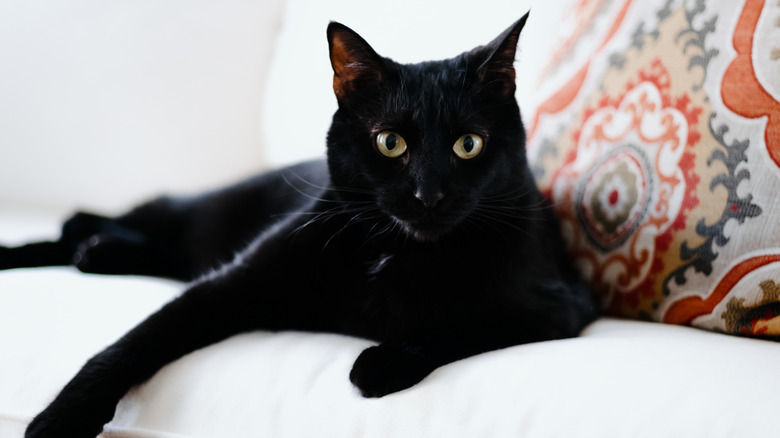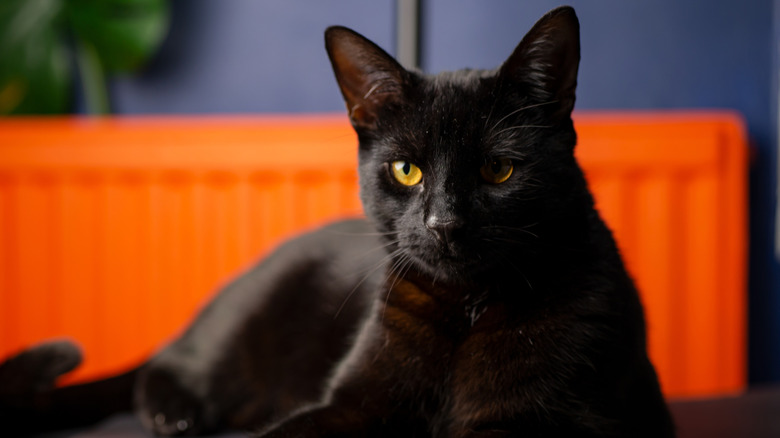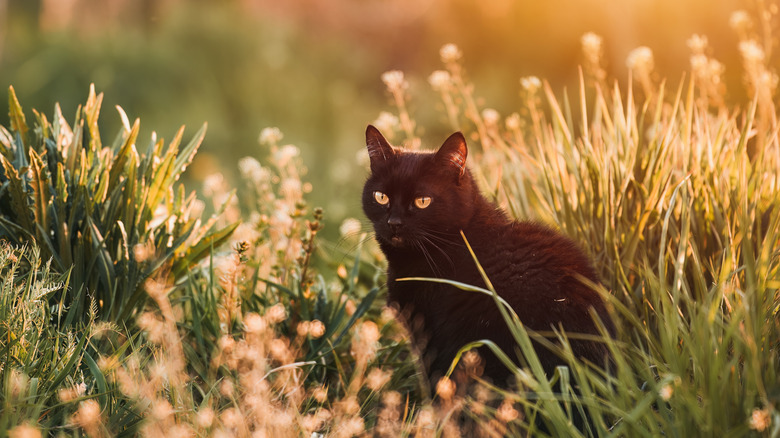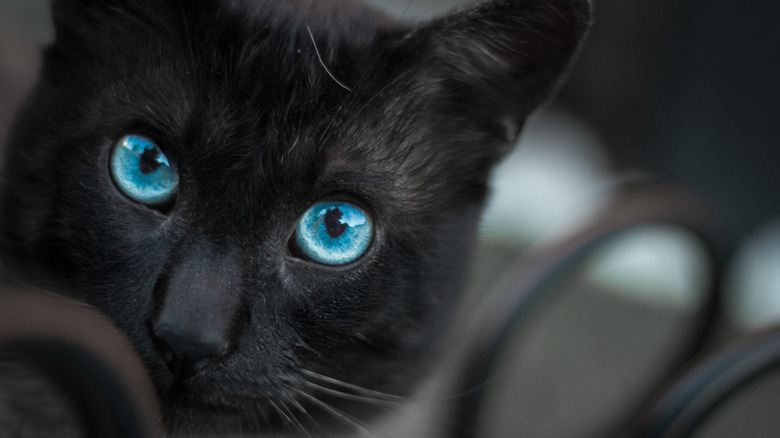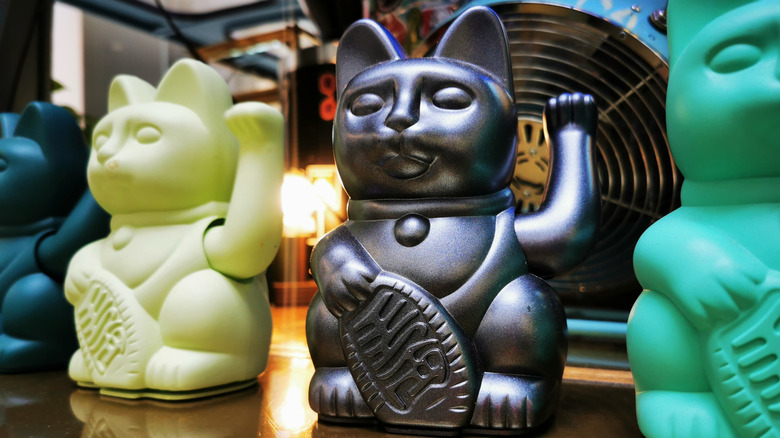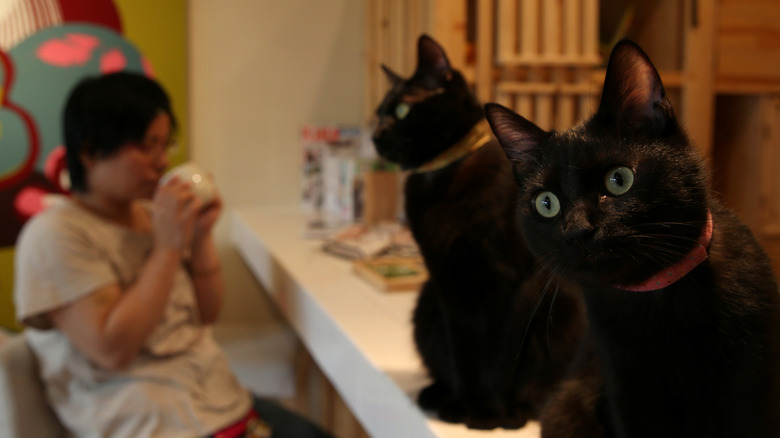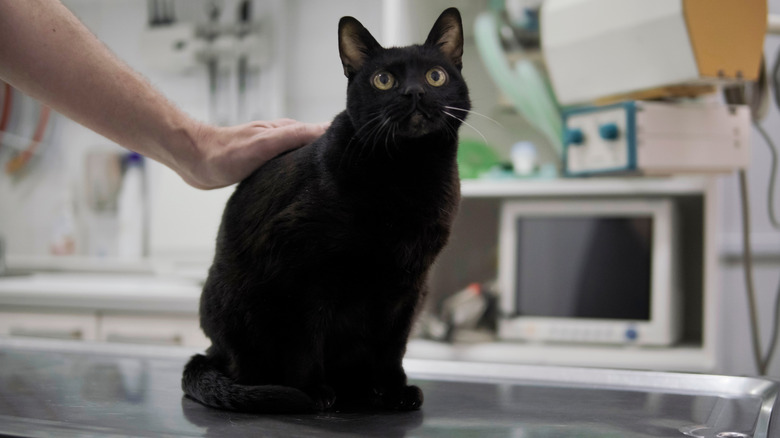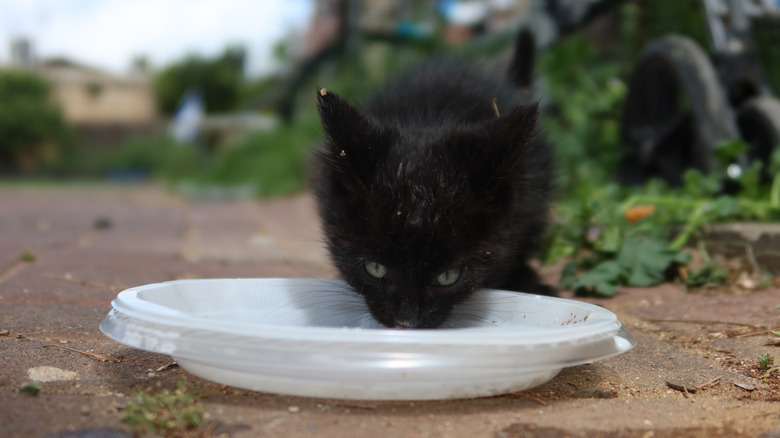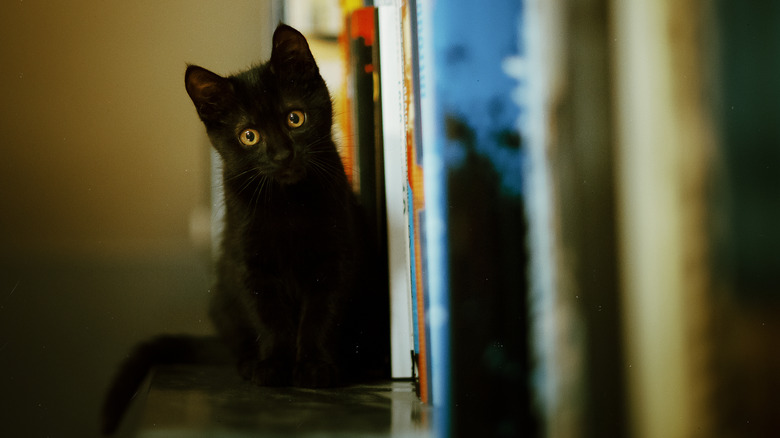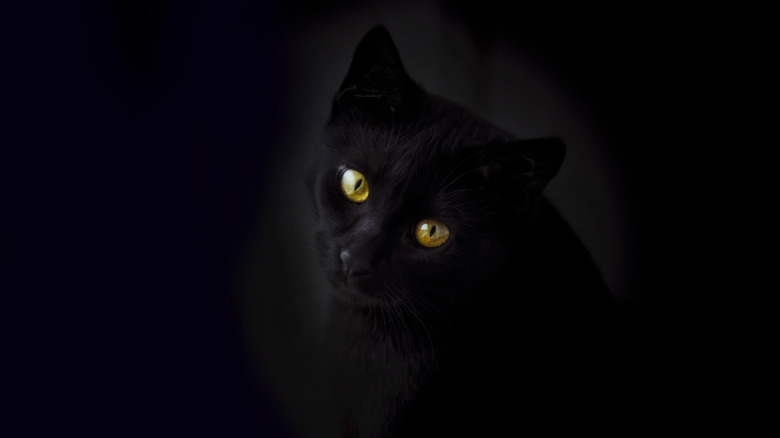10 Facts About Black Cats You Probably Didn't Know
Many people think of black cats as unlucky or associate them with witches and Halloween — images less rooted in fact than superstition and cultural bias. Black cats, despite their association with bad luck in some cultures, are actually considered lucky in certain parts of the world. You may already be aware that the ancient Egyptians revered cats of all colors, including black ones, as sacred animals with mystical powers. Indeed, their status ascended to that of symbols of the divine, offering protection and companionship even beyond this earthly existence and into the next life.
Black cats continue to fascinate and bedevil (in the best ways) us to this day. For example, did you know that their fur has a unique ability related to light absorption and reflection due to excess melanin? These felines have many fascinating characteristics, some of which go beyond fur-deep, that might surprise you. Curious to learn more? Here are some surprising facts about black cats you probably didn't know.
1. Only one cat breed is always black
While there are 22 recognized cat breeds that can have solid black coats, the Bombay stands out as the only breed that is always black. This unique characteristic sets the Bombay apart from other black-coated felines and makes it distinctive and beloved.
The origins of the Bombay can be traced back to the 1950s. It was created through a carefully planned breeding program by Nikki Horner, a Kentucky-based cat breeder. Horner aimed to combine the sleek, muscular body of the American shorthair with the striking black coat of the sable Burmese. The first successful crossbreed of the Bombay occurred in 1966, and the Cat Fanciers' Association officially recognized the breed in 1970.
The Bombay's appearance is reminiscent of a miniature black panther. It has a sleek, compact body with well-developed muscles and a rounded head. Its most distinctive feature is its glossy and dense jet-black coat. The breed's coat is so dark that it appears to absorb light, giving it an almost mystical aura. In addition to its striking appearance, the Bombay breed is known for its unique characteristics, including its affectionate and outgoing personality. These cats are incredibly social and crave human interaction. They are often described as "Velcro cats" due to their love of being held and cuddled. Bombays are also highly intelligent and curious, making them excellent companion animals for people of all ages.
2. Their coats can change color
It might come as a surprise, but a black cat's fur can change color from sitting in the sun. This happens because the sun's UV rays break down the pigment, eumelanin, which gives the fur its black color. As the eumelanin degrades, the fur loses its ability to absorb light efficiently, causing it to lighten into a reddish-brown hue. The extent of this rusting effect varies depending on the cat's genetics, health, and the duration of sun exposure. In some cases, the fading occurs gradually; in others, it can happen more quickly, especially if the cat spends long periods in direct sunlight.
Beyond sun exposure, another reason for a black cat's fur changing color is a deficiency in tyrosine, an amino acid needed to produce eumelanin. If a black cat's diet lacks enough tyrosine, its fur can fade. Adjusting the cat's diet or providing tyrosine supplements can help restore the dark color.
While these factors are the most common causes of fur fading, significant changes in coat color can sometimes signal underlying health problems, such as liver or thyroid issues. If your cat's fur changes dramatically, it's wise to consult a veterinarian. It's also important for cat owners to be mindful of sun exposure since overexposure to UV rays can pose health risks, including skin cancer. Providing shaded areas and limiting time in direct sunlight, especially during peak hours, is key to keeping cats safe and healthy.
3. Not all black cats have yellow eyes
There is a common misconception that all black cats sport yellow peepers. However, the same pigment responsible for their black fur, eumelanin, also influences their eye color. As such, black cats can have a range of eye colors, including yellow, gold, orange, copper, or green.
High levels of eumelanin in black cats typically result in both black fur and warm-toned eyes like yellow or orange. The gene responsible for black fur is dominant, so if a cat inherits it, the black coat is likely to be paired with these eye colors. While rare, some black cats can have blue eyes, a trait seen in the breed ojos azules (Spanish for "blue eyes").
4. Black cats are not evil or unlucky
Throughout history and across cultures, black cats have been seen as both lucky and unlucky, with negative perceptions largely based on fear rather than fact. In medieval Europe, they became linked to witchcraft. Black cats were thought to be witches' familiars or even witches in disguise, leading to their persecution. Some theorize this contributed to the spread of the bubonic plague, as killing cats reduced rodent control.
In contrast, black cats were seen positively in other contexts. British sailors believed black cats brought good luck on ships, helping ensure safe voyages by keeping rodents in check. Fishermen's wives also kept black house cats, believing they would protect their husbands at sea. In Japan, black cats are considered lucky, especially in love, as they are thought to attract suitors to single women. Similarly, Scottish folklore views a black cat on the doorstep as a sign of prosperity, while in France, black cats are called "money cats" and are associated with financial fortune.
5. Black cats are less likely to be adopted
Black cats, long shrouded in superstition and myth, continue to be associated with bad luck, witchcraft, and misfortune. Sadly, spurious alignment has had a profound impact on their adoption rates in shelters, according to a 2020 study. Compared to cats of other colors, black cats tend to linger in shelters, waiting longer for their forever homes. Unfortunately, the stigma against black cats is real and persistent. This unfair bias makes it harder for black cats to find their human families, despite the fact that their fur color has no bearing on their personalities or behavior.
Animal welfare organizations, such as the American Society for the Prevention of Cruelty to Animals, are working to combat these negative stereotypes through education and awareness campaigns that promote the adoption of black cats. By challenging these myths, they aim to give black cats an equal chance at being adopted and loved.
One place actively changing this perception is Nekobiyaka Cat Cafe in Himeji, Japan, the world's first and only cafe dedicated exclusively to black cats. Since opening in 2013, Nekobiyaka has helped black cats find forever homes, offering them a second chance and helping to break the stigma. Even during the struggles of the COVID-19 pandemic, the cafe continued its mission with the help of donations. Inside the cafe, each black cat wears a colorful bandana, allowing guests to tell them apart while watching them explore their thoughtfully designed environment.
6. Some black cats have hidden 'ghost markings' that come to light
Many black cats conceal subtle tabby patterns beneath their dark coats, a phenomenon known as "ghost markings." These faint stripes or spots become visible under certain lighting conditions, such as bright sunlight. This occurs because the gene responsible for black fur doesn't always completely suppress the tabby pattern gene, allowing these hidden patterns to emerge.
Understanding these markings provides insight into feline genetics and the complex interplay between coat color and pattern expression. Genetically, all cats carry the tabby pattern, but in black cats, the expression of this pattern is often subdued or completely masked. These markings come in four main varieties: ticked, mackerel, blotched, and spotted. They are typically more noticeable in kittens and may fade as the cat matures, though some adult black cats retain them throughout their lives.
7. The gene that makes cats black may also make them more resistant to infections
Black cats possess genetic traits that could offer valuable insights into disease resistance, particularly through the lens of CCR5, a gene crucial to immune responses. The melanism gene, responsible for their striking black fur, has been linked to enhanced immunity. Studies suggest that this gene provides resistance to diseases, such as feline immunodeficiency virus (FIV), echoing evolutionary patterns of pathogen resistance observed in other species.
Further research underscores CCR5's pivotal role in regulating immune responses. This gene facilitates macrophage recruitment, a key process in fighting infections and maintaining immune balance. CCR5 also influences the migration of memory CD8+ T cells, which are essential for long-term immune defense. These functions illustrate CCR5's importance in protecting against diseases, not just in humans but potentially in other species, including black cats.
The therapeutic potential of CCR5 further enhances its possible scientific significance. Advances in gene editing, particularly CRISPR/Cas9 technologies, have demonstrated CCR5's value in treating diseases such as HIV. These developments pave the way for exploring how similar interventions could be applied to felines, further illuminating novel interventions in humans and offering possibilities for cross-species studies into immunity and disease resistance.
8. A fairy creature takes the form of a black cat in Celtic mythology
In Celtic mythology black cats are often linked to the enigmatic figure of the Cat Sìth (or Cait Sidhe in Irish). This supernatural creature is typically depicted as a large black feline with a white spot on its chest. Legends describe the Cat Sìth as a fairy or, in some versions, a witch who could transform into a cat nine times — possibly giving rise to the popular belief that cats have nine lives.
The Cat Sìth is central to many superstitions, blending protective and ominous qualities. In Scottish folklore, it was feared as a soul-stealer, capable of claiming a person's soul by passing over their corpse before burial. To guard against this, communities would hold the Fèill Fhadalach, or "late wake," a vigil kept around the clock to ensure the Cat Sìth would not approach the deceased.
On a more benevolent note, the Cat Sìth played a role in Samhain traditions, a Celtic festival marking the precursor to Halloween. It was believed that the Cat Sìth would bless households that left out a saucer of milk, which in turn ensured that the family's cows continued to produce. However, those who failed to offer this gesture risked being cursed, with their livestock's milk drying up.
9. Black cats have long served as literary and political symbols
Black cats are a source of fascination in literature, representing themes of mystery, magic, and rebellion. In Edgar Allan Poe's "The Black Cat," Pluto serves as both victim and avenger, embodying guilt and karmic justice in a tale of psychological unraveling. Eiko Kadono's "Kiki's Delivery Service" features Jiji, a witty, talking black cat whose role as Kiki's confidant highlights the balance between independence and companionship in a magical coming-of-age story. Similarly, T.S. Eliot's "Old Possum's Book of Practical Cats" introduces Demeter, an elegant and clever black-and-gold feline who unmasks the notorious Macavity, reflecting the charm and mischief often associated with black cats.
One of literature's most memorable black cats is Behemoth from Mikhail Bulgakov's "The Master and Margarita." A demonic feline with a taste for chaos and gatling guns, Behemoth walks on two legs, speaks, and transforms into a human. His love for mischief, vodka, and satire makes him both a humorous and fearsome figure, embodying unpredictability and mayhem. His layered identity, referencing both the Biblical monster Behemoth and the Russian word "begemot" (hippopotamus), underscores the complex cultural resonance of black cats in literature.
Beyond fiction, black cats carry political symbolism, particularly in anarcho-syndicalism, a branch of anarchism focused on labor organizing. In the early 20th century, the black cat became an emblem of rebellion and resilience, tying the feline's independence and resourcefulness to collective struggles for justice. This political association adds depth to the mystique of black cats, linking them to themes of defiance and solidarity.
10. Black cats are particularly hard to photograph
Photographing black cats can be challenging due to their dark fur, which absorbs light and obscures fine details. This often confuses a camera's auto-exposure settings, leading to underexposed or washed-out images. Despite these challenges, employing the right techniques can reveal the unique beauty and personality of black cats.
Lighting is a key factor in achieving compelling photographs. Soft, diffuse light, such as natural daylight or illumination from a lamp, minimizes harsh shadows and stark contrasts. Shooting during the golden hour, just before sunset, provides ideal lighting conditions for photographing black cats. Adjusting camera settings can also enhance your results; underexposing the shot slightly helps maintain the richness of black fur. Additionally, avoiding flash is important to prevent unnatural reflections or the dreaded "green eye" effect, which can detract from the natural appearance of your furry subject.
Careful attention to composition ups the quality of black cat photography. Clean, clutter-free backgrounds help the cat remain the focal point, while mid-toned settings, such as grass or curtains, provide effective contrast. Alternatively, black-on-black compositions can create striking artistic effects, emphasizing the fur's texture. To highlight the cat's facial features, especially the eyes, positioning them to face a natural light source is essential. Rim lighting, created by placing a light source behind and slightly to the side of the subject, can add depth by outlining the fur's edges. Finally, subtle photo editing adjustments to highlights, shadows, and contrast can enhance the overall image without overwriting that authentic, fur-some look.
